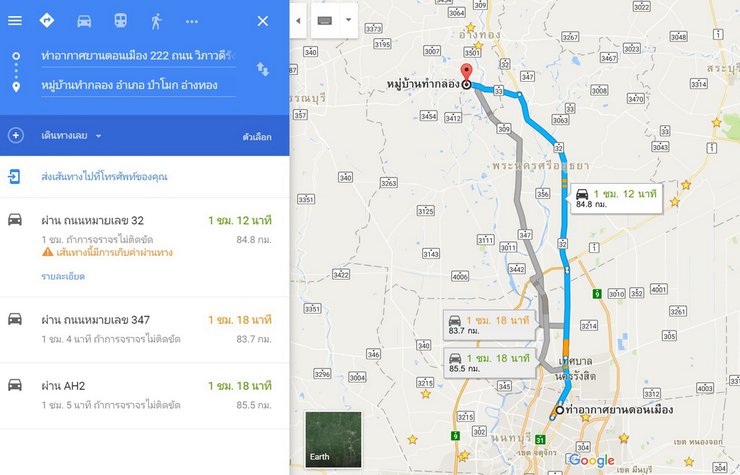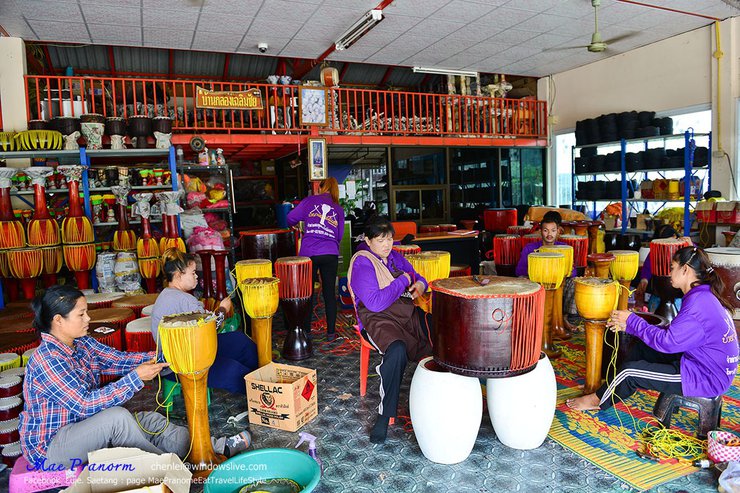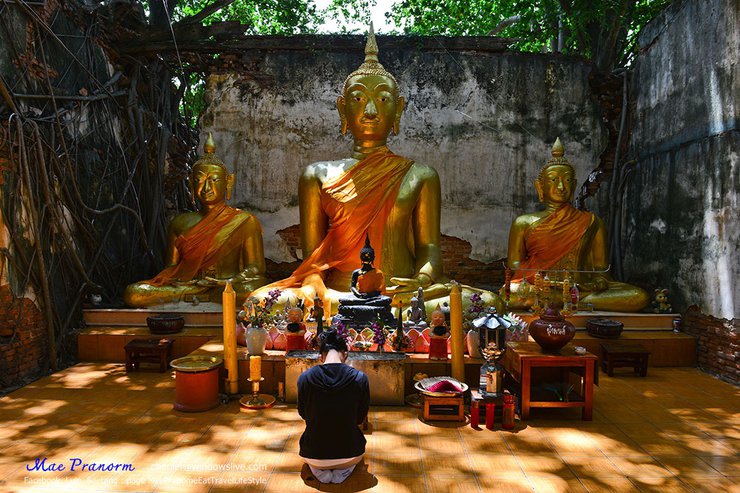A Trip to Ang Thong: Exploring the Charms of Thai Culture
On September 14, 2016, Mae Pranom attended the opening ceremony of the "Magic of Thai Ways" event, held from September 13-15 at the OTOP Community School in Bang Chao Cha, Pho Thong District, Ang Thong Province. The opening ceremony took place in the evening at 6:00 PM. During the day, Mae Pranom took the opportunity to explore the city of Ang Thong, which boasts numerous interesting tourist attractions. This review provides a glimpse into her experience and serves as a guide for potential visitors.
Let's all follow along and watch together.

You're welcome.
"Good morning, Ma'am Pranom. We departed from Bangkok at 9:00 AM."
The First Stop: A Village of Drum Makers
Our first stop was the drum-making village, located in Ekkarat Subdistrict (behind Pa Mok Market), Pa Mok District, Ang Thong Province. The drive from Bangkok took about an hour and a half.
Drum-Making Village
This is a concise and accurate translation of the Thai phrase "หมู่บ้านทำกลอง" into English. It conveys the meaning of the phrase without unnecessary embellishment, making it suitable for academic writing.
Renowned as the village producing the most famous and best drums in Thailand, the villagers have been making drums as a secondary occupation since the harvest season of 1927.
The drums here are made from **Azadirachta indica** wood, a softwood that is easy to carve. Another important material is **cowhide**, which is used to make the drumhead.
Visiting this drum-making village, tourists and enthusiasts can witness the entire drum-making process, from the initial wood carving to the final drum assembly and studding. Drums of various sizes are produced, ranging from small to large, including "klong that," "klong san," "klong yao," "klong ram wong," and temple drums, as well as miniature drums for souvenirs. The craftsmanship displayed in the drums is of exceptional quality, intricate, and aesthetically pleasing. Visitors can also purchase drums to take home as a memento of their visit.
The Drum Making Village also boasts the world's longest long drum, measuring 36 inches (92 centimeters) in diameter and 7.6 meters in length. Made from six sections of rain tree wood, this drum is a unique symbol of the village, signifying your arrival at the drum-making heartland of Ang Thong province. The drum stands prominently in front of the house of Kamnan Hongfa Yoyot, who built it in 1994 after a year of construction. Although drum-making villages are now rare in Thailand, this village has continuously preserved the traditional Thai drum-making process for generations. It is well worth a visit to learn about this increasingly rare example of Thai ingenuity. For more information, call 0-3566-1875.
Information from the Tourism Authority of Thailand

Upon arrival, a short drive will reveal drum shops and workshops lining both sides of the road.





Here, you can visit the drum-making process and purchase products at prices much lower than those in Bangkok.





After strolling until almost noon, we went to a famous old-style Pad Thai restaurant in Ang Thong.
Pad Thai Wat Thong Kung is a century-old ancient Pad Thai restaurant that has been passed down through four generations. Located within the Wat Thong Kung temple grounds, it offers a relaxed atmosphere with a riverside view.

The shop is located inside the temple.

This restaurant is truly popular. There are many customers dining in and ordering takeout.


The cool program has already been tasted by many.

The price is very cheap.

They use charcoal stoves here for stir-frying, and the taste is truly delicious.




Their Pad Thai also includes star fruit, which surprisingly complements the dish quite well.

Don't forget to order the Tom Yum pork noodles too. It's really delicious.


After we were full, we went to visit "Parok Potharam Church" at Wat Sangkathai, Ang Thong Province. It is a new Unseen tourist attraction in Ang Thong Province.
A newly discovered archaeological site in Ang Thong province, Thailand, features an ancient abandoned church with four banyan tree roots firmly gripping its walls. Inside the church lies a large Buddha statue.
Located in Moo 4, Sala Daeng Subdistrict, Mueang District, Ang Thong Province, not far from the Pad Thai restaurant we ate at.







The church has a total of 3 rooms.






The first room houses a revered Buddha statue, Luang Pho Kaen. The main hall features a large presiding Buddha statue, Luang Pho Wan Dee, flanked by two smaller statues, Luang Pho Si and Luang Pho Suk. The final room is currently empty.
The roofless church finds solace in the shade of a towering banyan tree, its branches forming a verdant canopy overhead. The ancient walls, weathered and cracked, stand firm thanks to the tenacious roots of the banyan, which have entwined the structure, providing unwavering support.
Data source: paiduaykan website.





Our next stop is the House of Iron Dolls.
Please Translate:
The Iron Doll House: A Creative Haven of Recycled Art
The Iron Doll House is a testament to the boundless creativity of Mr. Pairote Tanomwong. Using discarded spare parts from various engines, he has meticulously crafted a diverse collection of sculptures, including iconic robots from renowned films like Transformers, Star Wars, and Alien. These sculptures range in size from an impressive 2-4 meters to smaller, intricate figures.
Open daily from 9:00 AM to 5:00 PM. Admission fee is 20 baht per person (free for children under 120 cm tall).
Location: Asia Road (Highway No. 32), inbound lane, kilometer 55.5
41/2 Moo 6, Talat Kruat Subdistrict, Mueang District, Ang Thong Province
Tel: 081-3393345











Our next destination is Wat Muang, where we will pay respects to the world's largest Buddha statue, "Luang Pho Yai".
Please Translate:
Tourist attraction details
The abandoned temple, believed to have been built in the late Ayutthaya period (around 1687 CE), is located in the Mueang Wiset Chai district, which was once a prosperous frontier town. In 1767, Ayutthaya fell to the Burmese, who burned down houses, temples, and Buddha statues. The remaining ruins of temples and Buddha statues are scattered among the trees on a hill.
After Venerable Phra Khru Vibul Acharakun (Luang Pho Kasem Acharasupho) set up his tent for meditation, he realized that this area was once a deserted temple. He felt it was suitable for meditation practice. However, during his meditation, he had a vision of Luang Pu Khao and Luang Pu Daeng, who told him to help rebuild Wat Muang. They believed that Venerable Phra Khru, with his charisma, could restore Wat Muang, which would allow those who had previously resided there to be reborn. In the deserted temple, there were still white and red stones, which were the remains of Luang Pu Khao and Luang Pu Daeng. Later, Venerable Phra Khru Vibul Acharakun sculpted statues of the two monks and placed them over the white and red stones, naming them Luang Pu Khao and Luang Pu Daeng, respectively. This practice continues to this day. In 1983, Venerable Phra Khru Vibul Acharakun began the restoration and construction of various buildings. He received donations and volunteer labor, which helped with the construction. On August 6, 1984, the Ministry of Education officially recognized Wat Muang as a temple with resident monks. On October 24, 1984, Venerable Phra Khru Vibul Acharakun was appointed abbot of Wat Muang. Later, His Majesty the King granted the temple the status of a royal temple on September 12, 1986.
In 1991, Phra Viharn Ariyakun, along with devout citizens across the country, joined forces to raise funds for the construction of the world's largest Buddha statue, named Phra Buddha Maha Naminthra Sakyamuni Sri Visut Chai Chan, as a tribute to His Majesty the King. The statue stands at an impressive 62 meters wide and 93 meters tall, with a construction cost of approximately 160 million baht. The construction took 16 years, from 1992 to 2007. Currently, Wat Muang covers an expansive area of 72 rai, which was acquired by Phra Kru Viharn Ariyakun before his passing. The land serves as a center for the study of Buddhist scriptures, meditation practice for monks and the public, a hospital for monks, and a distribution center for Royal Project handicrafts.
For further inquiries, please call 0 3563 1556 or 0 3563 1974.
The temple is located approximately 8 kilometers west of Ang Thong town. If you are traveling from Bangkok, take the Asian Highway and enter Ang Thong town. Pass the market and turn right. Pass the prison and turn left at the intersection (towards Suphan Buri). Follow the Pho Phraya Tha Ruea route. The temple will be on your left-hand side.
Tourism Authority of Thailand












After an afternoon of sightseeing, we attended the opening ceremony of the "Enchanting Thai Way of Life" event held at the OTOP School in Bang Chao Cha Community, Pho Thong District, Ang Thong Province. This event is part of a project to promote activities that attract tourists.




The villagers prepared a delicious, authentic home-cooked meal for the event.

The Deputy Governor gave the opening remarks.

Followed by a local performance

They also went out to the store to sell things.






On the way back, we took a route through Ayutthaya to stop and enjoy a relaxing meal by the river at the Sala Ayutthaya Hotel.







Relaxing and enjoying a meal with a view of the majestic Phra Prang at Wat Phutthaisawan, situated along the Chao Phraya River, was such a delightful experience that I wished I could stay overnight.



After dinner, we sat and chatted until around 9 pm.
The one-hour drive back to Bangkok concluded the relaxed, one-day trip.
Let's take a relaxing day trip to Ang Thong.

Thank you for following.
Maenam Khun, sir.
แม่ประนอม
Friday, September 27, 2024 10:27 AM















